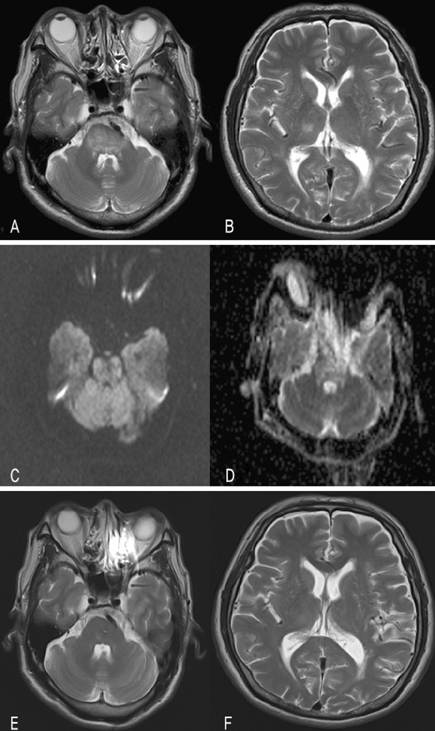J Clin Neurol.
2007 Mar;3(1):50-52. 10.3988/jcn.2007.3.1.50.
Two Cases of Hypertensive Encephalopathy Involving the Brainstem
- Affiliations
-
- 1Department of Neurology, College of Medicine, Cheju National University, Jeju, Korea. neurokang@cheju.ac.kr
- KMID: 1700687
- DOI: http://doi.org/10.3988/jcn.2007.3.1.50
Abstract
- Hypertensive encephalopathy is a medical emergency whose clinical manifestations are usually associated with bilateral parieto-occipital lesions. Predominant brainstem edema without accompanying occipital lesions is rare in hypertensive encephalopathy and usually occurs in patients with secondary hypertension. We describe the clinical and radiological features of two patients with reversible hypertensive brainstem encephalopathy. Both patients had chronic renal failure, but the extensive neuroimaging abnormalities revealed few clinical features of brainstem involvement. The clinical findings and neuroimaging abnormalities resolved once the hypertension was treated.
Keyword
MeSH Terms
Figure
Cited by 1 articles
-
Steroid-Responsive Recurrent Encephalopathy Associated with Subacute Thyroiditis
Yun Jae Chung, Kwang-Yeol Park, Jihyun Ahn, Sam-Yeol Ha, Young Chul Youn
J Clin Neurol. 2008;4(4):167-170. doi: 10.3988/jcn.2008.4.4.167.
Reference
-
1. Zeigler DK, Zosa A, Zileli T. Hypertensive encephalopathy. Arch Neurol. 1965. 12:472–478.
Article2. Venkata C, Ram S. Hypertensive encephalopathy: recognition and management. Arch Intern Med. 1978. 138:1851–1853.
Article3. Gifford RW. Management of hypertensive crises. JAMA. 1991. 266:829–835.
Article4. Hinchey J, Chaves C, Appignani B, Breen J, Pao L, Wang A, et al. A reversible posterior leukoencephalopathy syndrome. N Engl J Med. 1996. 334:494–500.
Article5. Schwartz RB, Jones KM, Kalina P, Bajakian RL, Mantello MT, Garada B, et al. Hypertensive encephalopathy: findings on CT, MR imaging, and SPECT imaging in 14 cases. Am J Roentgenol. 1992. 159:379–383.
Article6. Kang BW, Bae YJ, Cheon WH, Park SP, Suh CK. Two cases of hypertensive brainstem encephalopathy. J Korean Neurol Assoc. 2003. 21:535–538.7. Thambisetty M, Biousse V, Newman NJ. Hypertensive brainstem encephalopathy: clinical and radiographic features. J Neurol Sci. 2003. 208:93–99.
Article8. Cruz-Flores S, de Assis Aquino Gondim F, Leira EC. Brainstem involvement in hypertensive encephalopathy: clinical and radiological findings. Neurology. 2004. 62:1417–1419.
Article9. Hauser RA, Lacey DM, Knight MR. Hypertensive encephalopathy. Magnetic resonance imaging demonstration of reversible cortical and white matter lesions. Arch Neurol. 1988. 45:1078–1083.10. Covarrubias DJ, Luetmer PH, Campeau NG. Posterior reversible encephalopathy syndrome: prognostic utility of quantitative diffusion-weighted MR images. Am J Neuroradiol. 2002. 23:1038–1048.11. de Seze J, Mastain M, Stojkovic T, Ferriby D, Pruvo JP, Destee A, et al. Unusual MR findings of the brainstem in arterial hypertension. Am J Neuroradiol. 2000. 21:391–394.12. Schaefer PW, Buonanno FS, Gonzalez RG, Schwamm LH. Diffusion-weighted imaging discriminates between cytotoxic and vasogenic edema in a patient with eclampsia. Stroke. 1997. 28:1082–1085.
Article13. Morello F, Marino A, Cigolini M, Cappellari F. Hypertensive brain stem encephalopathy: clinically silent massive edema of the pons. Neurol Sci. 2001. 22:317–320.
Article
- Full Text Links
- Actions
-
Cited
- CITED
-
- Close
- Share
- Similar articles
-
- Two Cases of Hypertensive Brainstem Encephalopathy
- Predominant Hypertensive Brainstem Encephalopathy with Supratentorial Involvement: Case Report and Literature Review
- Reversible Obstructive Hydrocephalus Associated with Hypertensive Brainstem Encephalopathy
- Hypertensive Brainstem Encephalopathy with Extensive Supratentorial Involvement
- Hypertensive Brainstem Encephalopathy in a Patient with Acute Lacunar Infarction


